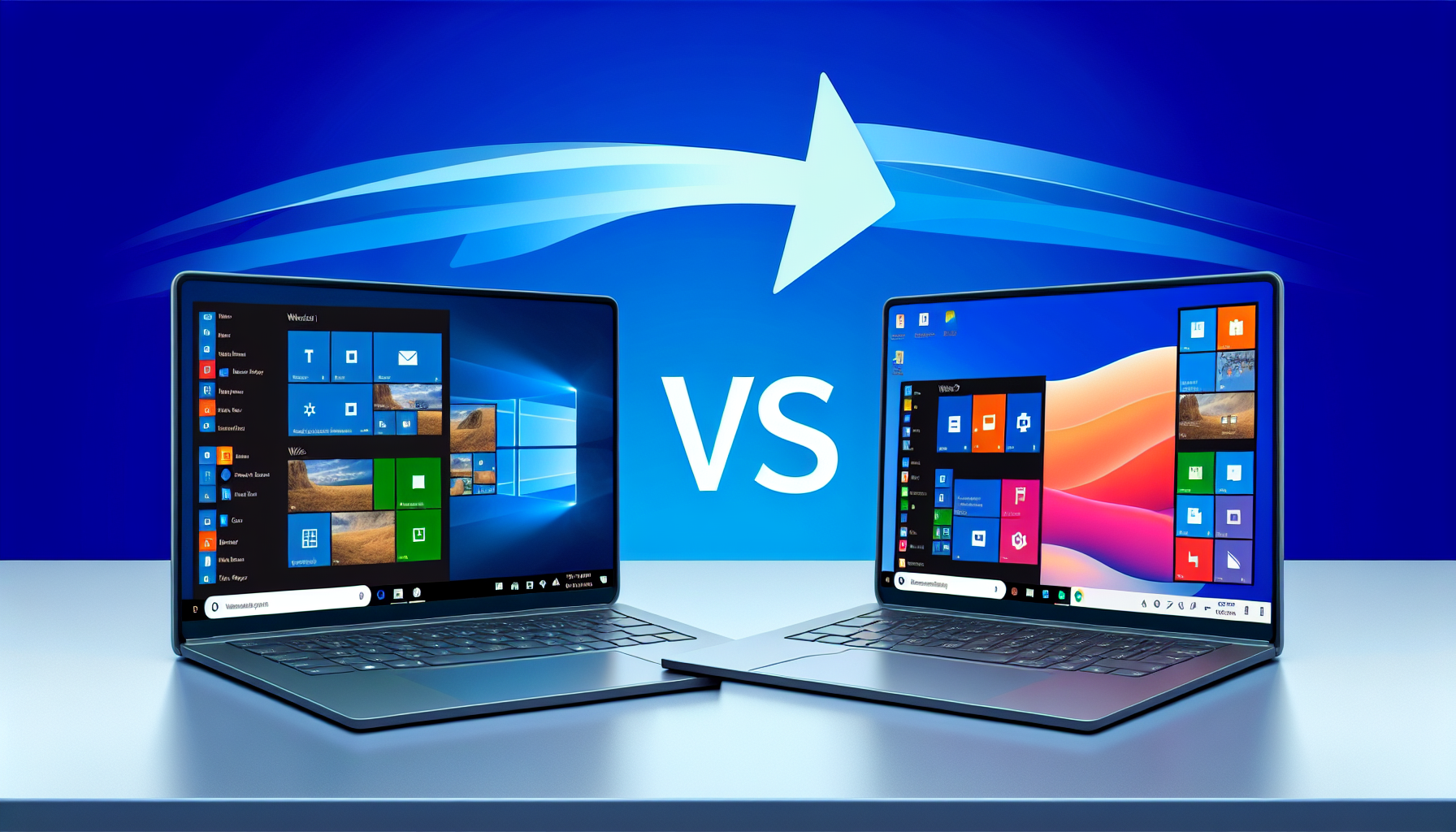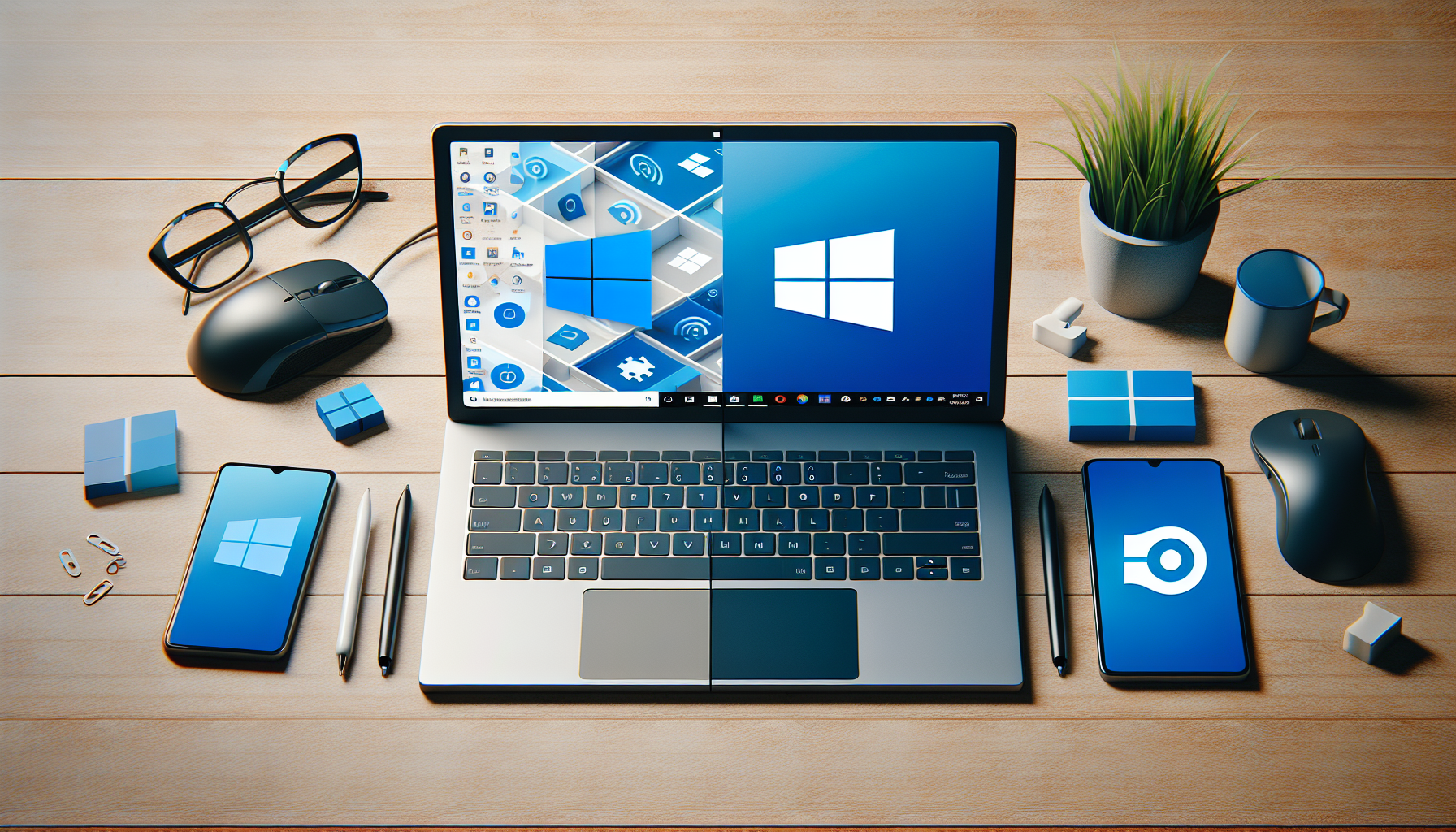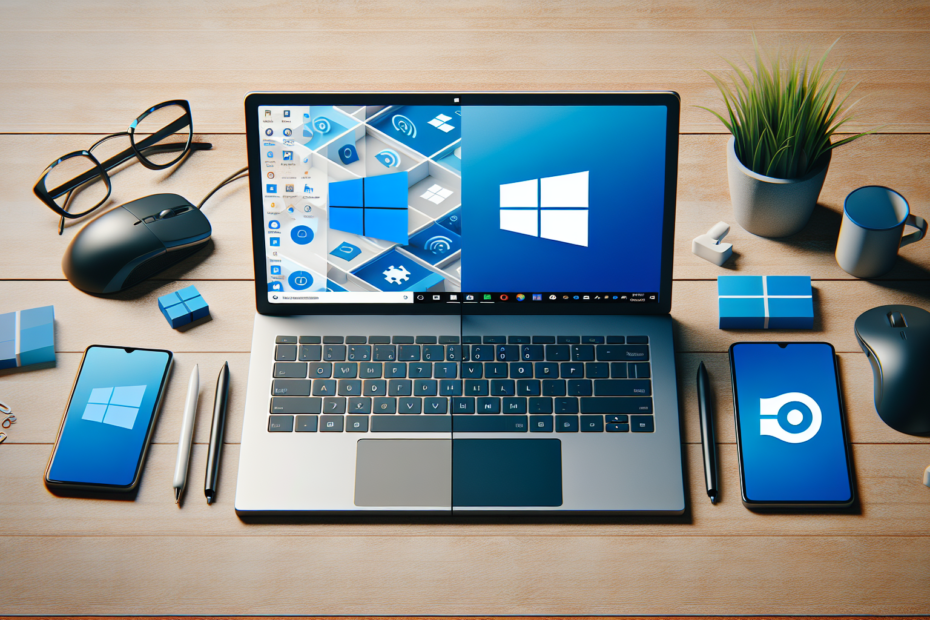







When it comes to choosing the right operating system for your laptop, the decision can be quite daunting. So, let’s dive into the question that is on everyone’s mind: Is Windows 10 or Windows 11 the better option? Each operating system has its own unique features and benefits, but which one truly reigns supreme on the laptop front? In this article, we will explore the key differences between Windows 10 and 11, highlighting the aspects that make one operating system stand out over the other. So grab your coffee, sit back, and let’s find out which version of Windows will take your laptop experience to new heights.
Performance
When it comes to performance, both Windows 10 and 11 have their strengths. Let’s delve into some key areas to help you make an informed decision for your laptop.
Boot time
Windows 11 boasts faster boot times compared to its predecessor, Windows 10. With improved optimizations and streamlined processes, you can expect a quicker startup experience with Windows 11, allowing you to get to work or play faster.
Hardware requirements
Both Windows 10 and 11 have similar hardware requirements, but Windows 11 introduces some additional specifications to take advantage of its new features and design. While Windows 10 can run smoothly on older hardware, Windows 11 may require a more modern CPU, TPM 2.0, and Secure Boot capabilities. However, Microsoft provides a helpful PC Health Check tool to determine if your laptop meets the requirements for Windows 11.
Resource usage
Windows 11 brings some enhancements in resource management, optimizing system resources more efficiently compared to Windows 10. This improved resource usage leads to smoother multitasking and better overall performance, allowing you to seamlessly switch between applications and enjoy a responsive computing experience.
User Interface
The user interface (UI) is an essential aspect of any operating system, as it directly impacts the user experience. Here’s a breakdown of the UI differences between Windows 10 and 11.
Start Menu
In Windows 10, the Start Menu is primarily functional, featuring a traditional layout with a list of installed applications and a search bar. On the other hand, Windows 11 introduces a centered Start Menu that combines app icons and recommended content in a visually appealing manner. The new Start Menu design in Windows 11 provides a more modern and immersive experience.
Taskbar and app icons
Windows 11 revamps the taskbar, positioning it at the center of the screen by default, giving it a more streamlined and centered appearance. The taskbar icons in Windows 11 also receive a refresh, featuring a cleaner look and providing quick access to commonly used apps and features. In Windows 10, the taskbar is positioned towards the bottom of the screen, with app icons represented in a slightly different style.
Virtual desktops
Virtual desktops allow you to organize and manage your open windows and applications more efficiently. Windows 10 and 11 offer virtual desktop functionality, enabling you to create multiple desktops for different tasks or workspaces. However, Windows 11 introduces a revamped Task View feature, making it easier to navigate between virtual desktops and manage your open windows more intuitively.

Compatibility
Compatibility is critical, as you want to ensure that your favorite software, hardware, and drivers work seamlessly with your chosen operating system. Let’s see how Windows 10 and 11 fare in this aspect.
Software compatibility
Windows 10 has been around for a while, which means it is compatible with an extensive range of software applications. Whether you rely on productivity tools, creative software, or gaming applications, Windows 10 has you covered. Windows 11, being the newer iteration, may require developers to update their software for optimal compatibility. However, Microsoft is working closely with developers to ensure a smooth transition and compatibility with popular software.
Hardware compatibility
Both Windows 10 and 11 are designed to support a wide variety of hardware configurations. If your laptop is already running Windows 10 smoothly, chances are it will be compatible with Windows 11 as well. However, as mentioned earlier, Windows 11 introduces specific hardware requirements, such as TPM 2.0 and Secure Boot. It’s best to check the PC Health Check tool or consult with the manufacturer to confirm compatibility.
Driver availability
Windows 10 has an extensive library of drivers available, ensuring compatibility with various hardware components. While Windows 11 may require updated drivers for optimal performance, Microsoft is actively collaborating with hardware manufacturers to ensure a smooth transition and availability of drivers. It’s advisable to check the manufacturer’s website or Microsoft’s official sources for driver updates when transitioning to Windows 11.
Security
Security is of utmost importance, especially when it comes to protecting your personal information and sensitive data. Here’s how Windows 10 and 11 handle security.
Security features
Both Windows 10 and 11 come equipped with a range of security features to safeguard your laptop. These include built-in Windows Defender antivirus software, firewall protection, and advanced threat protection. Windows 11 enhances security by introducing new features like Microsoft Defender Antivirus with Threat Intelligence, providing greater protection against emerging threats.
Regular updates
Receiving regular updates is crucial to ensure your operating system remains secure and up-to-date. Both Windows 10 and 11 receive regular updates from Microsoft, addressing security vulnerabilities and adding new features. However, Windows 11 benefits from being the newer version, as Microsoft tends to prioritize the release of major updates and security patches for the latest operating system.
Secure Boot
Secure Boot is a feature that prevents unauthorized operating systems or bootloaders from loading during the startup process. Both Windows 10 and 11 support Secure Boot. However, Windows 11 takes it a step further by requiring TPM 2.0, which provides an additional layer of security. Secure Boot, coupled with TPM 2.0, ensures a more secure boot process, protecting your laptop from potential malware attacks.

Gaming
If gaming is an essential aspect of your laptop usage, it’s important to consider which operating system provides the best gaming experience. Let’s see what Windows 10 and 11 have to offer for gamers.
DirectX support
DirectX is a collection of application programming interfaces (APIs) designed to enhance gaming performance and graphics. Both Windows 10 and 11 support DirectX 12, the latest version. However, Windows 11 offers additional performance optimizations for gaming, thanks to its improved resource management, resulting in smoother gameplay and better graphics.
Game Mode
Game Mode is a feature that allows you to optimize your laptop’s performance specifically for gaming. Both Windows 10 and 11 include Game Mode, enabling you to allocate system resources more efficiently and minimize background processes, ensuring a dedicated gaming experience. Windows 11 introduces refinements to Game Mode, optimizing performance even further and providing an enhanced gaming experience.
Compatibility with gaming hardware
Windows 10 and 11 are compatible with a vast array of gaming hardware, including graphics cards, controllers, and headsets. Whether you have the latest gaming peripherals or older devices, both operating systems offer support. However, with Windows 11’s focus on performance improvements, it may provide better compatibility and optimization with the latest gaming hardware, ensuring an immersive gaming experience.
Battery Life
Battery life is a crucial factor, particularly for laptop users who rely on their devices while on the go. Let’s explore how Windows 10 and 11 address power management and battery optimization.
Power management
Both Windows 10 and 11 offer power management features to help maximize battery life. These features include adjusting screen brightness, managing background processes, and optimizing power usage based on the laptop’s power source. Both operating systems have similar power management capabilities, ensuring efficient use of your laptop’s battery.
Battery optimization features
Windows 11 introduces some refinements and enhancements to battery optimization features compared to Windows 10. With improved resource management and efficiency, Windows 11 allows your laptop to squeeze out more battery life, extending your usage time when you’re away from a power source. While Windows 10 provides decent battery optimization, Windows 11 takes it a step further for better overall battery performance.
Sleep and hibernate modes
Sleep and hibernate modes are essential for conserving battery life when your laptop is not in use. Both Windows 10 and 11 offer these power-saving modes, allowing you to quickly resume your work or activities. However, Windows 11 improves on these features by reducing power consumption during these modes, resulting in further battery savings and extending your laptop’s usage time.
Productivity
For those using their laptops for work or other productivity tasks, it’s crucial to evaluate the operating system’s multitasking capabilities and productivity features. Let’s see how Windows 10 and 11 cater to productivity needs.
Multitasking capabilities
Windows 10 and 11 both offer solid multitasking capabilities, allowing users to run multiple applications simultaneously and switch between them seamlessly. However, Windows 11’s improved resource management and performance optimizations result in smoother multitasking, ensuring that you can handle various tasks efficiently without noticeable lag or slowdowns.
Taskbar features
The taskbar plays a significant role in enhancing productivity by providing quick access to frequently used applications and features. Windows 10’s taskbar offers similar functionality, but Windows 11 introduces refinements such as improved alignment options, the ability to personalize the taskbar, and a more streamlined design. These enhancements contribute to a more intuitive and efficient workflow, boosting productivity on your laptop.
Microsoft Office integration
Microsoft Office is a widely used productivity suite, and compatibility with this suite is crucial for many laptop users. Both Windows 10 and 11 integrate seamlessly with Microsoft Office applications like Word, Excel, and PowerPoint, allowing you to create, edit, and collaborate on documents effortlessly. Whether you’re working on Windows 10 or 11, you can expect a smooth experience with Microsoft Office applications, ensuring optimum productivity.
Accessibility
Accessibility features are essential for users with disabilities, enabling them to utilize their laptops effectively. Here’s how Windows 10 and 11 cater to accessibility needs.
Ease of use
Windows 10 and 11 strive to provide an intuitive and user-friendly experience for all users, including those with disabilities. Both operating systems offer accessibility features like a narrator and magnifier, making it easier for individuals with visual impairments to navigate and use their laptops effectively. Windows 11 introduces enhanced accessibility options, providing a more personalized and accessible experience overall.
Screen reader compatibility
Screen readers are crucial for individuals with visual impairments, as they convert on-screen text into audio. Both Windows 10 and 11 offer compatibility with popular screen reader software, allowing visually impaired users to navigate the operating system and various applications effectively. Microsoft continuously works on improving screen reader compatibility, ensuring a smooth experience for users who rely on this assistive technology.
Assistive technologies
Beyond screen readers, Windows 10 and 11 support various assistive technologies to cater to a range of disabilities. These technologies include speech recognition, on-screen keyboards, and eye-tracking devices. Both operating systems provide built-in support and compatibility for such assistive technologies, offering users with disabilities the tools they need to utilize their laptops effectively.
Customization
Customization options allow users to personalize their operating systems to suit their preferences, enhancing the overall user experience. Here’s how Windows 10 and 11 fare in terms of customization.
Themes and personalization
Windows 10 and 11 offer a wide range of themes and personalization options, enabling users to customize their desktops, taskbars, colors, and visual styles to reflect their individual tastes. While both operating systems provide similar customization options, Windows 11 introduces a refreshed and modernized design language, giving users more contemporary choices to personalize their laptops.
Desktop customization options
Windows 10 allows users to customize their desktops by placing icons, widgets, and shortcuts wherever they prefer. Windows 11 continues to offer these customization options, allowing users to organize their desktops to optimize their workflow. The centered taskbar in Windows 11 also helps free up horizontal space on the desktop, providing more room for customization and personalization.
Control Panel settings
Control Panel is a central hub for adjusting and customizing various settings in Windows. Windows 10 utilizes Control Panel for accessing and modifying system settings. With Windows 11, Microsoft introduces the modernized Settings app alongside Control Panel. Both Windows 10 and 11 offer access to these settings, making it easy to customize your laptop to fit your needs and preferences.
Price
Price considerations are important when deciding between Windows 10 and 11, especially if you’re on a budget or looking for the best value for your money.
Cost of upgrade
Windows 11 is available as a free upgrade for eligible Windows 10 users. If your laptop is compatible with Windows 11, you can take advantage of the upgrade at no additional cost, ensuring you have access to the latest features and improvements. However, if you’re on an older device that doesn’t meet the requirements for Windows 11, sticking with Windows 10 is a cost-effective option.
Availability of free updates
Both Windows 10 and 11 receive regular updates from Microsoft, ensuring that users have access to the latest features, security patches, and performance improvements. Windows 10 users can expect updates until October 14, 2025, while Windows 11 users can anticipate a longer support cycle. With free updates available for both Windows 10 and 11, you can enjoy a continuously evolving operating system experience without any additional charges.
Value for money
Determining the value for money depends on your specific needs and requirements. Windows 11, being the newer version, comes with numerous refinements and performance enhancements that can enhance your laptop experience. However, if your laptop already meets your needs with Windows 10 and you don’t require the additional features and compatibility of Windows 11, sticking with Windows 10 may provide better value for the time being.
In conclusion, both Windows 10 and 11 offer excellent options for your laptop, each with its own strengths and considerations. Windows 10 is a mature and reliable operating system that provides compatibility with a wide range of hardware and software, making it a cost-effective choice for many users. On the other hand, Windows 11 brings a fresh and modern user interface, improved performance, and enhanced security features, ensuring a more immersive and future-proof experience. Assess your specific needs, compatibility requirements, and budget to make the best decision for your laptop.





